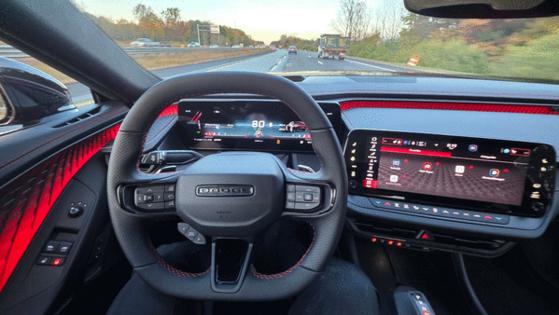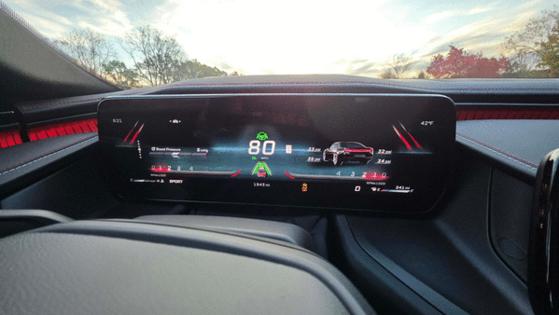Auto review: Charger unplugged! Dodge Sixpack muscle car is large and in charge
Published in Business News
ANN ARBOR, Michigan — In the early morning light, I rotated my gorgeous red 2026 Dodge Charger Sixpack Scat Pack onto empty Huron River Drive. I floored the throttle and awakened the beast. WAAUUUUUGHH! All four paws translated 531 pounds of torque to the asphalt and I exploded toward the twisties — my fingers rifling through the gears with steering-mounting paddle shifters. WHAP! WHAP!
The Dodge Charger is back, unplugged and untethered.
After three dark years in the government woodshed, Dodge has restocked its stable with an earth-pawing, gas-fed pony car next to the electric Charger Daytona. The Daytona was an answer to a question customers weren’t asking: what if we made the best-selling V-8 muscle car electric? Dodge sales fell off a cliff.
If the four-cylinder Ford Mustang II was the symbol of 1970s "Malaise Era" regulatory excess, then the charged Charger is the symbol of the 2020s' forced electric-vehicle push. It makes artificial V-8 sounds. It’s heavier than the Titanic. It jumped the shark.
But in reducing Stellantis NV’s exposure to government emissions fines, it served its purpose and helped rebirth the gas-powered Charger. The legendary Hemi V-8 is coming, but first: the 3.0-liter, 550-horse twin-turbocharged inline-6 cylinder Hurricane Sixpack. Sixpack as in the gateway drug to the hard stuff.
It ain’t too shabby.
I hammered the Charger Sixpack and Daytona EV Scat Packs across Washtenaw County’s rural roads. Based on a flexible chassis that can house gas and electric powertrains, the hatchback (more on that feature later) Chargers are beautiful to look at with their throwback, 1968-era fascias, Coke-bottle bods and digital interiors.
The Sixpack is six times better. The driving experience is more visceral, more alive, more genuine. Push the START button next to the naughty pistol-grip shifter and Sixpack growls menacingly. Start the Daytona EV and it roars to life. An electric roar? The sound is synthetic and its obnoxious volume only calls more attention to the forgery.
There’s nothing fake about the Daytona’s electric power, though. With a stump-pulling 623-pound feet of torque, the e-Charger slammed me into the back of the seat as I nailed it onto I-94. BRAWWWWWRRH! went the fake V-8 sound as I eclipsed (number withheld to preserve my license) mph.
But at 4,815 pounds, Sixpack weighs 20% less than Daytona, making it a lot more playful around the cloverleaf that prefaces the rocket launch into the four-lane. That lesser girth also means that, despite giving up 120 ponies to the 670-horse Charger Daytona, the Sixpack sports the same 1:8.7 power-to-weight ratio.
With 100% of torque available at launch, Daytona out-drags the Sixpack to 60 mph (3.3 seconds to 3.9), but the gas-guzzler is more fun everywhere else.
On an empty Huron Drive, I initiated launch control in the Sixpack by burying the brake pedal, then the accelerator. RPMs spiked to 3,000 and held — RRRRRGGGH — as I kept both feet in it.
Release the brake. Release the Kraken.
Like the EV, Sixpack comes standard with all-wheel drive to better harness the enormous power coming through its driveshafts. The Charger slewed right briefly on the cold morning asphalt before all four tires hooked up, launching me into fall splendor.
Sixpack offers $4,995 Customer Preferred Pack 22B, which includes goodies like wireless charging pad, ambient lighting, head-up display, auto windshield wipers, eight-way power seats, 360-degree camera, and a partridge in a pear tree.
Get it for the head-up display. It’s awesome.
I pulled the downshift paddle and automatically engaged the eight-speed tranny’s MANUAL mode. WHAP! In fourth gear, I entered a tricky right-left uphill complex. The horizontal tachometer in the head-up display was in my direct line of sight. 3,000 RPM. WHAP! I pulled the paddle again into 3rd gear and the engine screamed at 5,000 RPM.
I tore though the twisties, then upshifted to 4th at 6,000 RPM — the gear indicator right there in the head-up display — on my way to the moon.
That’s visceral fun the EV can’t provide. Good as the Sixpack was, I still dreamed of what the new Charger would feel like with a good ol’ Scat Pack V-8 at the other end of my lead foot.
“Have you looked at the new Charger Sixpack?” I asked a friend who owns a V8-powered, 2022 Charger Scat Pack.
“Yeah, it’s good looking,” he replied.
“Going to get one?”
“I’ll wait for the V-8.”
I get it. And when the V-8 comes, it will benefit from the same major chassis upgrades that make Sixpack a joy. When last-gen Charger (and its Challenger coupe stablemate) exited the market in 2023, they took with them an aging, rear-wheel-drive platform that could barely contain its Godzilla drivetrains.
Three years on and the new, all-wheel-drive STLA Large Platform is 25% stiffer. This is still a big car — gaining six inches in length and two inches of width over last gen. Add AWD, hatchback and more legroom and SixPack is a significant 500 pounds heavier than its predecessor. And that’s BEFORE you put a V-8 boat anchor up front.
The upgrades are all worth it.
I’ve touched on the benefits of a stiffer platform and AWD to keep this rocket on the road. But when you’re not setting fire to asphalt like a 4,800-pound Road Runner cartoon, you’ll find the car’s new-found utility commendable.
Readers of this column know I’m a missionary for hot hatches like the VW Golf GTI, Golf R, Mazda3 Turbo and Honda Civic Type R as the market’s best all-around value: fun, utilitarian, affordable. The Charger Sixpack is the world’s biggest hot hatch.
And relatively affordable. At $56,990, my tester was $10K cheaper than a comparably-equipped, inline-6-powered, $67K BMW 540i xDrive (not to mention the $64K Charger Daytona EV) while offering better looks, utility, rear legroom and speed.
Open the rear deck and Charger will swallow a cart-full of luggage. Flatten the rear seats and add bicycles to your cargo. It’s a taaaall hatch but Dodge has thoughtfully put the automatic OPEN/CLOSE button on the left rear of the trunk for easy access.
The four-door model will be preferred by most Charger customers, but the rear seats of the coupe model I tested are plenty big too — unlike, say, Mustang rear seats that require removal of your legs. Rear passengers will also benefit from the $995 panoramic roof option.
Cockpit ergonomics are typically superb for a Dodge product, with raised buttons on the steering wheel for adaptive cruise control, buttons on the back for volume/station changes. Drive modes hang below the left spoke so your hands never need leave the wheel.
So when you come up on a 375-horse BMW 540i on a cloverleaf, you can toggle SPORT mode and drag him off the exit.
As you blow by, be sure and shout: “The Charger is back, baby!”
2026 Dodge Charger
Vehicle type: All-wheel-drive, five-passenger coupe and sedan
Price: Base $51,990, including $1,995 destination charge. Sedan an extra $2,000. $67,360 Scat Plus coupe with Customer Preferred Package as tested
Powerplant: 3.0-liter, twin-turbo inline-6 cylinder
Power: 420 horsepower, 468 pound-feet torque (R/T); 550 horsepower, 531 pound-feet torque (Scat Pack)
Transmission: Eight-speed automatic
Performance: 0-60 mph, 3.9 seconds (Scat Pack, mfr.); top speed, 177 mph (Scat Pack)
Weight: 4,815 pounds
Range: EPA est. mpg, 16 city/26 highway/20 combined (Scat Pack); 91 octane fuel required
Report card
Highs: Gorgeous hot hatch; AWD/head-up display/hatchback goodies
Lows: Gets pricey; no V-8 yet
Overall: 4 stars
____
©2025 www.detroitnews.com. Visit at detroitnews.com. Distributed by Tribune Content Agency, LLC.





















Comments